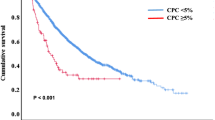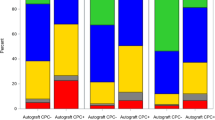Abstract
The significance of elevated C-reactive protein (CRP) prior to autologous stem cell transplantation (ASCT) in multiple myeloma (MM) has not been studied. We analyzed 1111 MM patients who underwent ASCT at Mayo Clinic from 2007 to 2015. A total of 840 patients (76%) received early ASCT (⩽12 months from diagnosis) and 271 patients (24%) received delayed ASCT (>12 months from diagnosis). Elevated CRP (> upper normal limit (8 mg/L)) was seen in 14% and 22% of patients undergoing early and delayed ASCT, respectively (P=0.003). There was no correlation of CRP with pre-transplant response, bone marrow plasma cell percentage or labeling index. Patients with an elevated CRP had a higher likelihood of having circulating plasma cells prior to ASCT (33 vs 19%; P<0.001). In the early ASCT cohort, the median overall survival (OS) in patients with normal and elevated CRP was not reached and 91 months respectively (P=0.011). In the delayed ASCT cohort, the median OS in respective groups were 73 and 30 months respectively (P<0.001), with elevated CRP being an independent prognostic marker on multivariate analysis (hazard ratio 2.0; 95% confidence interval, 1.0–3.8; P=0.045). Elevated pre-transplant CRP identifies a high-risk population especially in patients undergoing delayed ASCT and should be incorporated in the pre-transplant evaluation.
This is a preview of subscription content, access via your institution
Access options
Subscribe to this journal
Receive 12 print issues and online access
$259.00 per year
only $21.58 per issue
Buy this article
- Purchase on Springer Link
- Instant access to full article PDF
Prices may be subject to local taxes which are calculated during checkout


Similar content being viewed by others
References
Klein B, Zhang XG, Jourdan M, Content J, Houssiau F, Aarden L et al. Paracrine rather than autocrine regulation of myeloma-cell growth and differentiation by interleukin-6. Blood 1989; 73: 517–526.
Donovan KA, Lacy MQ, Kline MP, Ahmann GJ, Heimbach JK, Kyle RA et al. Contrast in cytokine expression between patients with monoclonal gammopathy of undetermined significance or multiple myeloma. Leukemia 1998; 12: 593–600.
Kishimoto T . The biology of interleukin-6. Blood 1989; 74: 1–10.
Yang J, Wezeman M, Zhang X, Lin P, Wang M, Qian J et al. Human C-reactive protein binds activating Fcgamma receptors and protects myeloma tumor cells from apoptosis. Cancer cell 2007; 12: 252–265.
Pineda-Roman M, Barlogie B, Anaissie E, Zangari M, Bolejack V, van Rhee F et al. High-dose melphalan-based autotransplants for multiple myeloma: the Arkansas experience since 1989 in 3077 patients. Cancer 2008; 112: 1754–1764.
Offidani M, Corvatta L, Polloni C, Piersantelli MN, Galieni P, Visani G et al. Serum C-reactive protein at diagnosis and response to therapy is the most powerful factor predicting outcome of multiple myeloma treated with thalidomide/ anthracycline-based therapy. Clin lymphoma myeloma 2008; 8: 294–299.
Lust JA, Lacy MQ, Zeldenrust SR, Witzig TE, Moon-Tasson LL, Dinarello CA et al. Reduction in C-reactive protein indicates successful targeting of the IL-1/IL-6 axis resulting in improved survival in early stage multiple myeloma. Am j hematol 2016; 91: 571–574.
Palumbo A, Avet-Loiseau H, Oliva S, Lokhorst HM, Goldschmidt H, Rosinol L et al. Revised international staging system for multiple myeloma: a report from International Myeloma Working Group. J clin oncol 2015; 33: 2863–2869.
Mikhael JR, Dingli D, Roy V, Reeder CB, Buadi FK, Hayman SR et al. Management of newly diagnosed symptomatic multiple myeloma: updated Mayo Stratification of Myeloma and Risk-Adapted Therapy (mSMART) consensus guidelines 2013. Mayo Clin proc 2013; 88: 360–376.
Rajan AM, Rajkumar SV . Interpretation of cytogenetic results in multiple myeloma for clinical practice. Blood cancer j 2015; 5: e365.
Rajkumar SV, Fonseca R, Dispenzieri A, Lacy MQ, Lust JA, Witzig TE et al. Methods for estimation of bone marrow plasma cell involvement in myeloma: predictive value for response and survival in patients undergoing autologous stem cell transplantation. Am j hematol 2001; 68: 269–275.
Gertz MA, Dingli D . How we manage autologous stem cell transplantation for patients with multiple myeloma. Blood 2014; 124: 882–890.
Gertz MA, Ansell SM, Dingli D, Dispenzieri A, Buadi FK, Elliott MA et al. Autologous stem cell transplant in 716 patients with multiple myeloma: low treatment-related mortality, feasibility of outpatient transplant, and effect of a multidisciplinary quality initiative. Mayo Clin proc 2008; 83: 1131–1138.
Kaplan EL, Meier P . Nonparametric estimation from incomplete observations. J Am Stat Assoc 1958; 53: 457–481.
Orlowski RZ, Gercheva L, Williams C, Sutherland H, Robak T, Masszi T et al. A phase 2, randomized, double-blind, placebo-controlled study of siltuximab (anti-IL-6 mAb) and bortezomib versus bortezomib alone in patients with relapsed or refractory multiple myeloma. Am j hematol 2015; 90: 42–49.
Moreau P, Attal M, Pegourie B, Planche L, Hulin C, Facon T et al. Achievement of VGPR to induction therapy is an important prognostic factor for longer PFS in the IFM 2005-01 trial. Blood 2011; 117: 3041–3044.
Kim JS, Kim K, Cheong JW, Min YH, Suh C, Kim H et al. Complete remission status before autologous stem cell transplantation is an important prognostic factor in patients with multiple myeloma undergoing upfront single autologous transplantation. Biol blood marrow transplant 2009; 15: 463–470.
Lee SE, Yoon JH, Shin SH, Eom KS, Kim YJ, Kim HJ et al. Bone marrow plasma cell assessment before peripheral blood stem cell mobilization in patients with multiple myeloma undergoing autologous stem cell transplantation. BioMed res int 2014; 2014: 982504.
Chakraborty R, Muchtar E, Kumar SK, Buadi FK, Dingli D, Dispenzieri A et al. Impact of pre-transplant bone marrow plasma cell percentage on post-transplant response and survival in newly diagnosed multiple myeloma. Leuk lymphoma 2017; 58: 308–315.
Rawstron AC, Child JA, RMd Tute, Davies FE, Gregory WM, Bell SE et al. minimal residual disease assessed by multiparameter flow cytometry in multiple myeloma: impact on outcome in the Medical Research Council Myeloma IX Study. J Clin Oncol 2013; 31: 2540–2547.
Chakraborty R, Muchtar E, Kumar SK, Jevremovic D, Buadi FK, Dingli D et al. Risk stratification in myeloma by detection of circulating plasma cells prior to autologous stem cell transplantation in the novel agent era. Blood cancer j 2016; 6: e512.
Chng WJ, Gertz MA, Chung TH, Van Wier S, Keats JJ, Baker A et al. Correlation between array-comparative genomic hybridization-defined genomic gains and losses and survival: identification of 1p31-32 deletion as a prognostic factor in myeloma. Leukemia 2010; 24: 833–842.
Szczepek AJ, Belch AR, Pilarski LM . Expression of IL-6 and IL-6 receptors by circulating clonotypic B cells in multiple myeloma: potential for autocrine and paracrine networks. Exp hematol 2001; 29: 1076–1081.
Mele A, Offidani M, Visani G, Marconi M, Cambioli F, Nonni M et al. Technetium-99m sestamibi scintigraphy is sensitive and specific for the staging and the follow-up of patients with multiple myeloma: a multicentre study on 397 scans. Br j haematol 2007; 136: 729–735.
Alexandrakis MG, Kyriakou DS, Passam FH, Malliaraki N, Christophoridou AV, Karkavitsas N . Correlation between the uptake of Tc-99m-sestaMIBI and prognostic factors in patients with multiple myeloma. Clin lab haematol 2002; 24: 155–159.
Walker R, Barlogie B, Haessler J, Tricot G, Anaissie E, Shaughnessy JD Jr. et al. Magnetic resonance imaging in multiple myeloma: diagnostic and clinical implications. J clin oncol 2007; 25: 1121–1128.
Bartel TB, Haessler J, Brown TL, Shaughnessy JD Jr., van Rhee F, Anaissie E et al. F18-fluorodeoxyglucose positron emission tomography in the context of other imaging techniques and prognostic factors in multiple myeloma. Blood 2009; 114: 2068–2076.
Paiva B, Paino T, Sayagues JM, Garayoa M, San-Segundo L, Martin M et al. Detailed characterization of multiple myeloma circulating tumor cells shows unique phenotypic, cytogenetic, functional, and circadian distribution profile. Blood 2013; 122: 3591–3598.
Rossi JF, Fegueux N, Lu ZY, Legouffe E, Exbrayat C, Bozonnat MC et al. Optimizing the use of anti-interleukin-6 monoclonal antibody with dexamethasone and 140mg/m2 of melphalan in multiple myeloma: results of a pilot study including biological aspects. Bone marrow transplant 2005; 36: 771–779.
Binder M, Rajkumar SV, Ketterling RP, Dispenzieri A, Lacy MQ, Gertz MA et al. Occurrence and prognostic significance of cytogenetic evolution in patients with multiple myeloma. Blood cancer j 2016; 6: e401.
Artz AS, Logan B, Zhu X, Akpek G, Bufarull RM, Gupta V et al. The prognostic value of serum C-reactive protein, ferritin, and albumin prior to allogeneic transplantation for acute myeloid leukemia and myelodysplastic syndromes. Haematologica 2016; 101: 1426–1433.
Sonneveld P, Broijl A . Treatment of relapsed and refractory multiple myeloma. Haematologica 2016; 101: 995.
Acknowledgements
Author contributions
RC designed the study, analyzed the data, wrote the first draft and approved the final version of the manuscript. MAG designed the study, analyzed the data, wrote the first draft and approved the final version of the manuscript. EM designed the study, analyzed the data, revised the manuscript critically and approved the final version of the manuscript. MAG, SKK, FKB, DD, AD, SRH, WJH, PK, MQL and NL performed patient management, revised the manuscript critically, participated in final data analysis and approved the final version of the manuscript.
Author information
Authors and Affiliations
Corresponding author
Ethics declarations
Competing interests
The authors declare no conflict of interest.
Additional information
Supplementary Information accompanies this paper on Bone Marrow Transplantation website
Supplementary information
Rights and permissions
About this article
Cite this article
Chakraborty, R., Muchtar, E., Kumar, S. et al. Elevated pre-transplant C-reactive protein identifies a high-risk subgroup in multiple myeloma patients undergoing delayed autologous stem cell transplantation. Bone Marrow Transplant 53, 155–161 (2018). https://doi.org/10.1038/bmt.2017.228
Received:
Revised:
Accepted:
Published:
Issue Date:
DOI: https://doi.org/10.1038/bmt.2017.228



